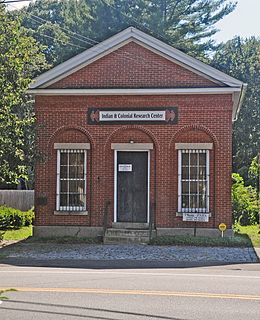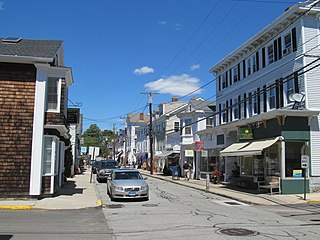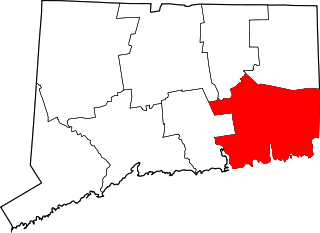
The Samuel L. Smith House is located at 5035 Woodward Avenue in Midtown Detroit, Michigan. It was also known as the Schools Annex. It was listed on the National Register of Historic Places in 1986.

Trinity Church is an historic church on Church Street in Brooklyn, Connecticut. Completed in 1771 and little altered since, it is the oldest Episcopal church in the state. Its congregation now meets mainly in a newer church at 7 Providence Street in Brooklyn Center, but still uses this building for special events. The building was added to the National Register of Historic Places in October 1970.

The former Reading Municipal Building is a historic building at 49 Pleasant Street in Reading, Massachusetts. Built in 1885, this two-story brick building was the town's first municipal structure, housing the town offices, jail, and fire station. In 1918 all functions except fire services moved out of the building. It now serves as Reading's Pleasant Street Senior Center. The building was listed on the National Register of Historic Places in 1984.
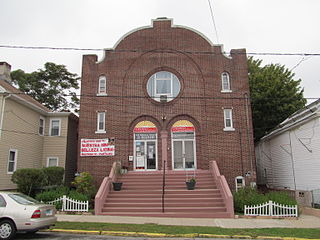
The Ohev Sholem Synagogue is a historic synagogue building at 109 Blinman Street in New London, Connecticut. Built in 1920, good example of the Classical Revival and Colonial Revival style applied to synagogue architecture. The building served a religious function until 1974, when it was sold to a Latino community organization. The building was listed on the National Register of Historic Places in 1995 for its architectural significance.

The Former First Baptist Church is a historic church building at 37 Main Street in Skowhegan, Maine. Built in 1842-44, this Greek Revival brick building is one of the few works attributable to a local master builder, Joseph Bigelow. It was used as a church until 1919, after which it was used as a community center, and then a VFW hall until 2009. It is vacant, with plans to establish a performance and meeting venue; it was listed on the National Register of Historic Places in 1991.

The Old Stonington High School is a historic school building at 25 Orchard Street in Stonington, Connecticut. It was built in 1888, and is a distinct and high quality local example of Second Empire architecture. The building was listed on the National Register of Historic Places in 1978; it has been converted to residential use. This building is not to be confused with the town's modern high school of the same name in Pawcatuck.

The Rossie Velvet Mill Historic District is located in the Mystic village of Stonington, Connecticut. Its main focus is the former Rossie Velvet Mill, a large brick industrial facility on the east side of Greenmanville Avenue that is now a research center for the nearby Mystic Seaport Museum. The district extends along Greenmanville Avenue between Pleasant Street in the north and the museum complex in the south. Most of the buildings in the district are residential housing built to house workers at the mill, and were built between about 1850 and 1950. The district includes 51 properties in 120 acres (49 ha). The district was listed on the National Register of Historic Places on March 9, 2007.

The Whitehall Mansion is a historic house at 42 Whitehall Avenue in the Stonington side of Mystic, Connecticut. Built about 1771 for a local physician and politician, it is a fine example of late Georgian architecture. It has been moved twice, both times short distances, and now serves as a bed and breakfast inn. The house was added to the National Register of Historic Places on April 12, 1979.

The Simsbury Bank and Trust Company Building, also known as the former Town Hall Building, is a historic commercial and civic building at 760 Hopmeadow Street in Simsbury, Connecticut. Built in 1917, it is a prominent local example of Colonial Revival architecture with Beaux Arts features. It originally housed the town's first bank, and was its town hall between 1969 and 1984. The building was listed on the National Register of Historic Places in 1986.
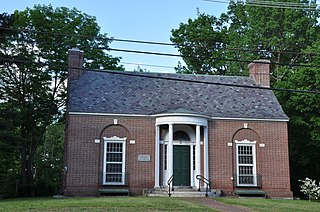
The Boscawen Public Library is the public library of Boscawen, New Hampshire, United States. It is located at 116 North Main Street. The library's first building, built in 1913 to a Colonial Revival design by Guy Lowell, was listed on the National Register of Historic Places in 1981, and is slowly undergoing rehabilitation.

The North Weare Schoolhouse is a historic school building on Old Concord State Road in northern Weare, New Hampshire. Built about 1856, it is a stylistically distinctive vernacular mixing of Federal, Greek Revival, and Italianate styling. It is the most architecturally distinctive of Weare's surviving 19th-century schoolhouses. It was used as a public school until 1952, and then served as a grange hall until the 1980s. The building was listed on the National Register of Historic Places in 1995.

The Old Kennebunk High School, also known as the Park Street School, is an historic former school building at 14 Park Street in Kennebunk, Maine. Built in 1922-23 to a design by Hutchins & French of Boston, Massachusetts, it is historically significant for its role the city's education, and architecturally as a fine example of a "modern" high school building of the period with Colonial Revival styling. It was listed on the National Register of Historic Places in 2011.

The District No. 8 School, also known locally as the Brick School, is a historic school building on United States Route 7 in Georgia, Vermont. Built in 1891, it was one of the last district schools to be built in the state, which mandated town control over schools the following year. It now houses the collection of the Georgia Historical Society and is known as the Brick Schoolhouse Museum. It was listed on the National Register of Historic Places in 1998.

The United Bank Building is a historic commercial building at 19-21 Main Street in downtown New Milford, Connecticut. Designed by Wilson Potter and built 1902-04, it is a prominent local example of Classical Revival architecture, built to house two banks whose previous buildings had been destroyed in a devastating fire. The building was listed on the National Register of Historic Places in 1982, and is a contributing element of the New Milford Center Historic District.

The Winter Street School is a historic school building at 165 Winter Street in Haverhill, Massachusetts. Built in 1856, it is one of the city's oldest surviving school buildings, and a good local example of Second Empire/Italianate architecture. The building was listed on the National Register of Historic Places in 1986. The building has been converted into apartments.

The Commercial Trust Company Building, also known locally as the Anvil Building, and now The Apartments at Anvil Place, is a historic commercial building at 55 West Main Street in downtown New Britain, Connecticut. Built in 1927, it is a distinctive example of Romanesque Revival architecture with Gothic features. It was listed on the National Register of Historic Places in 2009, and is a contributing property to the Downtown New Britain historic district.
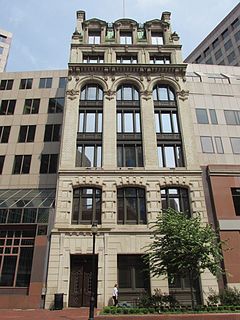
The First National Bank Building is a historic commercial building at 50-58 State House Square in the heart of downtown Hartford, Connecticut. Built in 1899, it is a fine local example of Beaux Arts architecture, and was one of the first of Hartford's commercial buildings to have a steel frame. It was listed on the National Register of Historic Places in 1984.

Footguard Hall is the headquarters and armory of the First Company Governor's Footguard of the state Connecticut, a ceremonial military company founded in 1771 and originally tasked with protecting the governor and state legisature. It is located at 159 High Street, in a Romanesque Revival brick building built in 1888. The building was listed on the National Register of Historic Places in 1984 in recognition of the organization's history and its distinctive architecture.

The Bullet Hill School is a historic school building on Main Street in Southbury, Connecticut. Built in the last decade of the 18th century, it is one of the oldest brick school buildings in the state of Connecticut. It was listed on the National Register of Historic Places in 1972.

